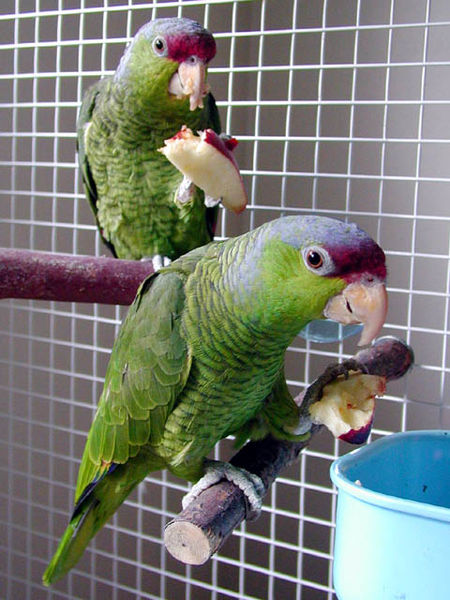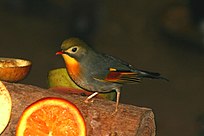The 27-30 parrots in the Genus Amazona, collectively known as “Amazons”, are among the world’s most popular avian pets. Indeed, they represent, at least to the general (i.e. “non-bird keeping”) public, the “typical” parrot. But they are far from typical in any manner, and the various species, while sharing some characteristics, differ greatly from one another.
I’d like to devote a good deal of time to this important and popular group, with an emphasis on the general personality traits of the various species. I’ll start here with those that are well-suited for beginners, and in future articles will cover larger Amazons, as well as some of the lesser-known and rare species. I’ll also include information on Amazons in the wild from time to time.
Range
Amazons of one kind of another range throughout much of Central and South America, and also occur on a number of Caribbean islands. The group includes quite common, rare and recently-extinct species.
General Characteristics
Amazons are feisty birds overall, much given to noisy bickering among themselves and nearly always on the go. They are quite hardy, with longevities exceeding 80 years for some species. They are considered by aviculturists to among the most intelligent and trainable of the parrots, and many individuals learn to speak well. Most bond strongly to their owners, and so make great companions.
Choosing a Species
Because the various Amazons are superficially similar – medium to large, mainly green, stoutly-built parrots with short, rounded tails, there is sometimes a tendency to lump them together, as regards their suitability as pets. However, as I hope to illustrate, care should be taken to match one’s personality with that of the parrot when choosing a pet. Of course, individual birds vary greatly within the same species, but there are some general species’ characteristics that can be helpful.
Surprisingly, the qualities mentioned in the preceding section render some Amazon species as poor choices for beginning parrot-keepers. Some are just too strong-willed and feisty, and need a great deal of room and attention. They quickly learn (almost always far sooner than their owners!) how to dominate their caretakers, and what they can get away with. These types, which I’ll cover in the future, are best left to experienced keepers.
Neophyte parrot fanciers do best with the smaller, quieter varieties that tend to have calm demeanors and a less “pushy” personality. I’ll start off with some examples of these.
Lilac-Crowned or Finsch’s Amazon, Amazona finschi
 Although well-known in captivity, this delightful parrot’s natural range is limited to foothills and mountainous terrain in western Mexico. The green feathers have a dark tint to their edges, lending the bird a quite unique appearance, and there is an attractive purple cast to the head. One of the smaller Amazons, it tops out at about 12 inches in length.
Although well-known in captivity, this delightful parrot’s natural range is limited to foothills and mountainous terrain in western Mexico. The green feathers have a dark tint to their edges, lending the bird a quite unique appearance, and there is an attractive purple cast to the head. One of the smaller Amazons, it tops out at about 12 inches in length.
Lilac-crowned Amazons are shyer than most of their relatives, and well-suited to a calm owner and quiet household. They are good talkers, and, if handled gently, make fine pets.
Blue-Fronted Amazon, Amazona aestiva aestiva
 The large range of this parrot extends from northeastern Brazil to Paraguay and northern Argentina. It seems, fortunately, to be a bit more resilient than other parrots as regards habitat loss, and is still to be found in good numbers in many areas.
The large range of this parrot extends from northeastern Brazil to Paraguay and northern Argentina. It seems, fortunately, to be a bit more resilient than other parrots as regards habitat loss, and is still to be found in good numbers in many areas.
Slightly larger than the lilac-crowned Amazon, the blue-fronted is also a good deal more vigorous and definitely a bit more of a challenge, That being said, it is an easily managed bird in the right hands, and is regarded as an excellent talker. They are quite energetic, and need to kept busy if they are to do well.
Blue-fronted Amazons have always been popular in Europe, but lag behind other Amazons here in the USA. Green in color and topped with a blue and yellow head, their unusually large eyes lend them a sensitive, “knowing” demeanor.
You can read about the natural history and conservation needs of the lilac-crowned Amazon at:
http://www.birdlife.org/datazone/species/index.html?action=SpcHTMDetails.asp&sid=1670&m=0
Lilac Crowned Amazon Photo referenced from Wikipedia, originally published by Ruth Rogers, and shared under Creative Commons Share 2.0
Blue-fronted Amazon picture referenced from Wikipedia, originally published by Snowmanradio, and shared under Creative Commons Share 2.0
 That Bird Blog – Bird Care and History for Pet Birds
That Bird Blog – Bird Care and History for Pet Birds

 I first made my acquaintance with Pekin robins while working for a bird importer, but did not really get to know them well until I again met up with them as a Bronx Zoo bird keeper. Housing them in a large, mixed species aviary there, I was able to appreciate their many interesting behaviors. They are always on the move…bathing, hunting and exploring, more so than most birds.
I first made my acquaintance with Pekin robins while working for a bird importer, but did not really get to know them well until I again met up with them as a Bronx Zoo bird keeper. Housing them in a large, mixed species aviary there, I was able to appreciate their many interesting behaviors. They are always on the move…bathing, hunting and exploring, more so than most birds. The golden conure is a bird that demands attention…indeed, a more strikingly-colored parrot can hardly be imagined. This, coupled with a playful demeanor and rarity in the wild and captivity, renders it one of the most desirable of all cage birds.
The golden conure is a bird that demands attention…indeed, a more strikingly-colored parrot can hardly be imagined. This, coupled with a playful demeanor and rarity in the wild and captivity, renders it one of the most desirable of all cage birds.  The caiques are unique among South American parrots in displaying a white breast. This is set off, in this species, by the bright green wings and back and a black face and crown. The abdomen, thighs and under-tail are yellowish-orange.
The caiques are unique among South American parrots in displaying a white breast. This is set off, in this species, by the bright green wings and back and a black face and crown. The abdomen, thighs and under-tail are yellowish-orange. The white breasted caique has a more limited range than its black-capped cousin, and is less commonly seen in captivity as well. Three subspecies occur through eastern Peru, northern Bolivia and northern Brazil. It is native to eastern Ecuador as well, but its continued presence there is now uncertain.
The white breasted caique has a more limited range than its black-capped cousin, and is less commonly seen in captivity as well. Three subspecies occur through eastern Peru, northern Bolivia and northern Brazil. It is native to eastern Ecuador as well, but its continued presence there is now uncertain.